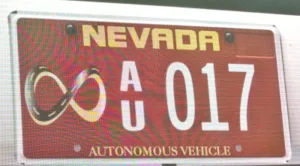
Kia proudly claimed it had been issued Nevada’s first autonomous vehicle license license plate (photo), while Mercedes Benz said its 2017 E-Class is the first “standard-production” vehicle to receive an autonomous license from the state. (Photo: Ken Werner)At TU Automotive’s off-site one-day conference, somewhat confusingly called the “Consumer Telematics Show,” auto industry professionals address topics such as “From Assisted to Autonomous Driving,” “Automotive Cybersecurity 2015,” “The Future of the Connected Customer Relationship,” and “The Platform Jungle.”
After Steve Banfield, CMO of INRIX, discussed the opportunities offered by cloud-mediated big data, a questioner asked how service suppliers can measure the quality of user-submitted data. He mentioned news articles that described Los Angeles residents uploading false reports of traffic incidents on WAZE so that WAZE users would avoid driving through the uploaders’ neighborhood. Banfield agreed this was a significant issue but said that statistical outliers can be detected if the data sets are large enough. Well, yes, but the incident in question involved a small data set that affected a presumably significant number of drivers, who would never know they had been spoofed if they didn’t read the news articles. One could envision many such incidents, some with more sinister motives than simply keeping traffic out of your neighborhood.
In “Regulating Auto Tech: Winnning Consumer Trust,” a panel containing an attorney and an insurance executive, as well as consultiants and the Head of the UK Department of Transport’s Head of the Centre for Connected and Autonomous Vehicles, quickly focused their comments on over-the-air (OTA) upgrades. That almost exclusive focus did not seem pre-planned, and the panelists seemed to be working out the issues and the solutions as they talked to each other.
The consumer trust of the session title was an issue because vehicle owners have to trust the manufacturers to the extent that the consumers will opt into downloading upgrades. If one owner chooses to download uploads 1, 3, and 7, while another dowloads 1,2, and 4 (and so on), auto manufacturers will find themselves trying to support many variants of each vehicle, so with mixes of downloads that were never intended to play with each other in the absence of the missing downloads.
This is where the panel members seemed to start thinking as they went along. The consensus? If manufacturers warranted each update’s usbility and fitness for use, they could require the installation of each update as a requirement for maintaining the vehicle’s warranty and insurer’s could require it for insurability. Will safety checks be needed to ensure that all essential software updates have been installed? Certainly, manufacturers don’t want to be forced into a confrontational position with their customers. Sensitive customer communication and interaction will be essential.
A separate download/upgrade issue is how do you handle a download that changes the car’s regulatory or insurance status? This is not merely theoretical. Las summer, Tesla offered an (optional and extra-cost) download that turned the Type S into a semi-autonomous vehicle.
In the conference’s final panel session, “Making Autonomous Driving a Reality,” the conversation turned to the various levels of vehicle automation. The National Highway Traffic Safety Administraton (NHTSA) defines five levels of vehicle automation.
Level 0: No automation
Level 1: Function-specific automation, such electronic stability control and ABS. This is standard today.
Level 2: Combined function automation. An example is adaptive cruise control combined with lane centering. Such systems are widely available today as extra-cost options.
Level 3: Limited self-driving automation. The driver can, under certain conditions, cede full control of all safety-critical functions to the vehicle. The driver must be available for occasional control, or to take over when conditions are no longer suitable for self-driving.
Level 4: Full self-driving automation. The driver is expection to provide destination or navigation input, but not to control the vehicle at any time during a trip.
The panel members said that Level 2 is an impressive offering that makes commutes much less tiring. Level 4 is much harder to do, but Level 3 is very tricky because it requires the driver to switch from complete uninvolvement to taking full control, perhaps rather quickly (although the NHTSA definition specifies that a reasonable amount of time should be provide for the driver to do this). People tend not to be good at this sort of transition. One panel member offered that this may be an impossible scenario and we may have to leap from Level 2 to Level 4. (I suspect that this might just extended to certain kinds of roads or routes – e.g. initially only “approved” highways/motorways, but later to all – Man. Ed.)
A final comment was “Don’t forget the social component of the human-car interaction.” As the car does more, the driver is likely to anthropomorphize the car. Man-machine communication would be optimized if the car could respond in kind. “Hello, Chevy….”

